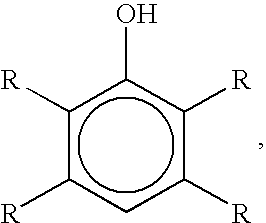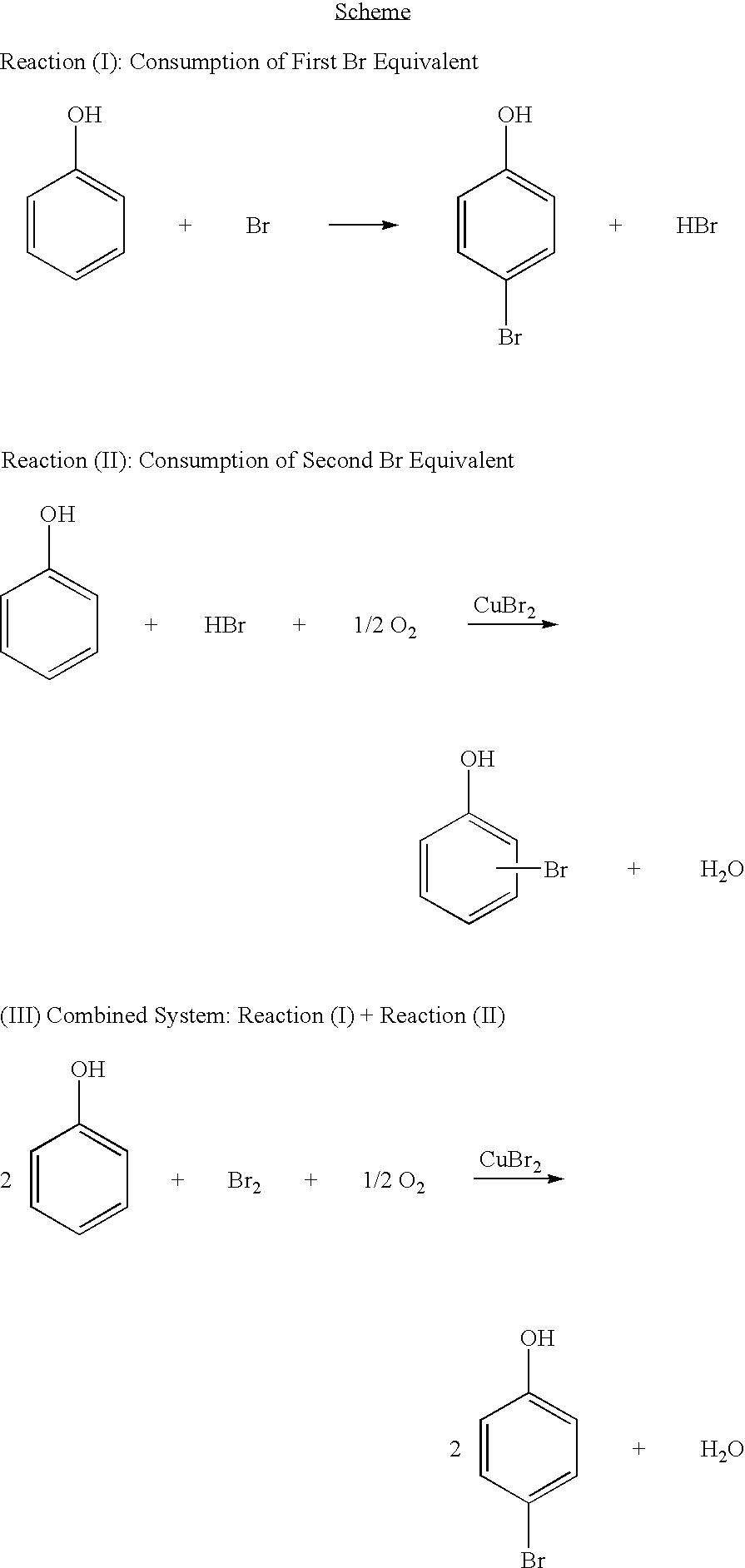Bromination of hydroxyaromatic compounds
a technology of hydroxyaromatic compounds and bromination, which is applied in the direction of organic halogenation, chemistry apparatus and processes, and process inefficient utilization of bromine, etc., can solve the problems of 50% conversion of elemental bromine to brominated products, and achieve the effect of eliminating the formation of hbr, increasing the conversion of elemental bromine, and being new and efficien
- Summary
- Abstract
- Description
- Claims
- Application Information
AI Technical Summary
Benefits of technology
Problems solved by technology
Method used
Image
Examples
example 1
[0034]To a round bottom flask equipped with a magnetic stir bar and a reflux condenser was charged 55.4 g (0.58 moles) of phenol and 43.6 mL of water. Then an addition funnel containing 19.8 g (0.12 moles) of Br2 was attached. Br2 was added drop wise at room temperature with mixing. By GC analysis, 16% of the phenol was converted to a mixture of brominated phenolics. To this mixture, 3.57 g (0.02 moles) of CuBr2 were added, and the resulting mixture was transferred to an autoclave reactor equipped with a mechanical stirring mechanism and subjected to 34.0 atm of air at 65° C. for one hour. Analysis of the resulting mixture by GC showed an additional 9% conversion of phenol to brominated phenolics. With respect to the initial mixture, 25% conversion of phenol was observed with 62% 4-bromophenol selectivity and 78% monobromophenol selectivity. The efficiency with respect to the initial charge of bromine was 72%.
example 2
[0035]To a round bottom flask equipped with a magnetic stir bar and a reflux condenser was charged 55.4 g (0.58 moles) of phenol, 3.57 g (0.02 moles) of CuBr2 and 43.6 mL of water. Then an addition funnel containing 19.8 g (0.12 moles) of Br2 was attached. Br2 was added drop wise at room temperature with mixing. The resulting mixture contained 1.44 wt. % 2-bromophenol, 8.17 wt. % 4-bromophenol and 6.67 wt. % 2,4-dibromophenol as determined by GC analysis of the mixture. The mixture was transferred to an autoclave reactor equipped with a mechanical stirring mechanism and subjected to 34.0 atm of air at 65° C. for one hour. Analysis of the resulting mixture by GC showed an additional 10% conversion of phenol to brominated phenolics. With respect to the initial mixture, 27% conversion of phenol was observed with 63% 4-bromophenol selectivity and 77% monobromophenol selectivity. The efficiency with respect to the initial charge of bromine was 75%.
example 3
[0036]To an autoclave reactor equipped with a mechanical stirrer and a glass liner was charged 55.4 g (0.58 moles) of phenol, 3.57 g (0.02 moles) of CuBr2 and 43.6 mL of water. In a separate reservoir attached to an Eldex metering pump a solution containing 22.3 g of Br2 in 82.5 g of acetic acid. The reactor was pressurized with 34.0 atm of air and heated to 65° C. The Br2 containing solution was then pumped into the reactor at a rate corresponding to 0.09 g Br2 / min until 33.9 g (0.06 moles of Br2) of the mixture was added. The reaction was allowed to proceed for 20 min. after addition of Br2 was stopped. Analysis of the resulting mixture by GC showed 15% conversion of phenol with 63% 4-bromophenol selectivity and 76% monobromophenol selectivity. The efficiency with respect to the initial charge of bromine was 90%.
PUM
| Property | Measurement | Unit |
|---|---|---|
| temperature | aaaaa | aaaaa |
| temperature | aaaaa | aaaaa |
| temperature | aaaaa | aaaaa |
Abstract
Description
Claims
Application Information
 Login to View More
Login to View More - R&D
- Intellectual Property
- Life Sciences
- Materials
- Tech Scout
- Unparalleled Data Quality
- Higher Quality Content
- 60% Fewer Hallucinations
Browse by: Latest US Patents, China's latest patents, Technical Efficacy Thesaurus, Application Domain, Technology Topic, Popular Technical Reports.
© 2025 PatSnap. All rights reserved.Legal|Privacy policy|Modern Slavery Act Transparency Statement|Sitemap|About US| Contact US: help@patsnap.com



